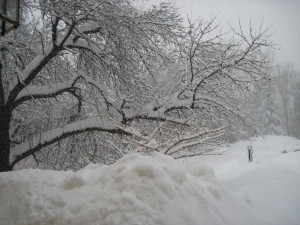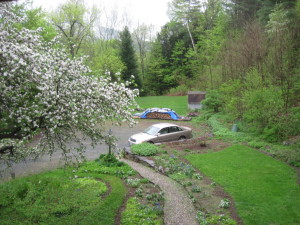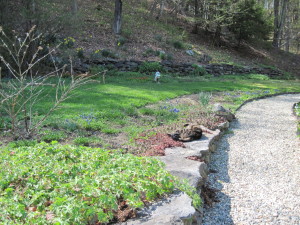It’s late February as I write this and I’m having a major attack of cabin fever. It began this morning when I turned on my computer, saw the screen saver I loaded the beginning of November and hated it, really hated it. Superficially it doesn’t look inflammatory. It’s merely a view of my front yard in winter:

At the time I uploaded it, it lifted my spirits and I enjoyed seeing it every time I turned on my computer. Back then all traces of fall color had long vanished; the periods of daylight were getting shorter, and the scenes they illuminated darker and duller. Back then I longed for enough snow to cover the ground and brighten things up again. As a substitute, the screensaver worked.
But after a long and sometimes brutal winter, seeing all that winter white on my computer as well through my office windows became depressing instead of uplifting. I wanted and needed a picture that would remind me that no matter how bad this winter’s weather was it, too, would pass like all the winters before it. This led to an entertaining period during which I looked at all my pictures of springs past in this house. By the time I’d narrowed it down to two pictures, I knew I’d make yet again.
Seeing the old apple tree in blossom no more than 5 yards from the front door reminded me of an early sign of spring I’d already experienced this year but forgot: the sound of some inexperienced male blue jay attempting to signal his claim on this territory by beating a tattoo on my roof with his beak. I knew it was an inexperienced male because mature birds of all species view the tree as a neutral zone. They share the blossom’s nectar, the apples, apple seeds and any insects attracted to same, as well as the suet in its feeder. In all the years I’ve lived here, I have never seen any bird attempt to build a nest in the tree. It’s as if the young jay’s failure to claim the space serves as a warning to all the newbies.
forgot: the sound of some inexperienced male blue jay attempting to signal his claim on this territory by beating a tattoo on my roof with his beak. I knew it was an inexperienced male because mature birds of all species view the tree as a neutral zone. They share the blossom’s nectar, the apples, apple seeds and any insects attracted to same, as well as the suet in its feeder. In all the years I’ve lived here, I have never seen any bird attempt to build a nest in the tree. It’s as if the young jay’s failure to claim the space serves as a warning to all the newbies.
What makes this particular avian display an unlikely method to maintain a territory is that my roof is a standing seam metal one. Although I’ve never attempted to bang on such a roof with my head (since I don’t have a beak), I assume that this is not a rewarding experience because the birds who do it quickly abandon the project. What I don’t know is whether the adult jays deliberately withhold this information from some or all of the young males for some reason. All the mature adults seem to recognize the tree as a communal food source. While their behavior in the tree may be more rowdy than that of members of more dignified species, no one gets hurt and they do wait their turn at the feeder. The willingness of all the jays to do this seems to suggest that information regarding proper tree-related behavior somehow has been passed from parent to offspring.
If so, why not point out to young males that hoping to claim a space as close to the tree as possible by banging their beaks on a metal roof isn’t worth the effort? Perhaps this behavior serves as a cautionary lesson to young males of all the avian species who might consider claiming all of the tree’s rich resources for themselves who may lack the shock-absorbing anatomy of the jay’s skull. In such a way, a futile but not fatal bit of beak-banging by one may benefit many. Or maybe this is the mature male jays’ idea of a hilarious teaching moment. They see some hotshot young male high on testosterone who thinks he’s going to claim the tree and ignores advice from his elders that this is not a smart thing to do, and decide to let him figure it out for himself. Off he flies to the end of the roof closest to the tree, perhaps with visions of making his elders eat crow (metaphorically speaking) when he’s a smashing success. Meanwhile they find convenient perches high in the apple tree from which to watch. Do they chuckle when the cocky young male gives up after a brief volley and flies back to the woods to recover? I wouldn’t put it past them because like crows, they do seem to exude a special brand of joie de vivre.
Thinking of this caused me to recall other signs of spring I’d missed as testosterone levels rise with the increasing daylight. Even though I possess only a tiny fraction of avian knowledge compared to many, I do know that the calls of some birds are also changing. And while all still respect the apple tree’s neutral status, same-species males are becoming less tolerant of each other’s presence than they were a month ago.
Meanwhile Bamboo who showed no desire to venture outdoors in December and January goes out on sunny days even when it’s much colder than it was then. Admittedly, he doesn’t go far. Until I dug a path through the high pile of snow to the feeder that also obstructed his view of the tree, he would go to the end of the front walk to ascertain the status of the stone wall. The more of it exposed, the longer he stayed there. This makes sense because unlike the tree, the wall serves as home to the rodent species he considers worthy prey. Once satisfied, he then went just far enough down the driveway to observe the apple tree and its inhabitants from there.
Since I made the path to the tree, he stands on the walk and watches the birds for a while in what to me seems like a thoughtful way before checking out the wall again.
 For now the wall remains buried. But come March 1st when I publish this, who knows? In this crazy winter that may not be the case. But once the wall does emerge, I image that Bamboo’s thoughts and mine both will turn to how much
For now the wall remains buried. But come March 1st when I publish this, who knows? In this crazy winter that may not be the case. But once the wall does emerge, I image that Bamboo’s thoughts and mine both will turn to how much
he enjoys blissfully taking advantage of the wall’s sun-warmed capstones in the early spring.
I don’t know about Bam, but I can hardly wait.
It’s late February as I write this and I’m having a major attack of cabin fever. It began this morning when I turned on my computer, saw the screen saver I loaded the beginning of November and hated it, really hated it. Superficially it doesn’t look inflammatory. It’s merely a view of my front yard in winter:
At the time I uploaded it, it lifted my spirits and I enjoyed seeing it every time I turned on my computer. Back then all traces of fall color had long vanished; the periods of daylight were getting shorter, and the scenes they illuminated darker and duller. Back then I longed for enough snow to cover the ground and brighten things up again. As a substitute, the screensaver worked.
But after a long and sometimes brutal winter, seeing all that winter white on my computer as well through my office windows became depressing instead of uplifting. I wanted and needed a picture that would remind me that no matter how bad this winter’s weather was it, too, would pass like all the winters before it. This led to an entertaining period during which I looked at all my pictures of springs past in this house. By the time I’d narrowed it down to two pictures, I knew I’d make yet again.
Seeing the old apple tree in blossom no more than 5 yards from the front door reminded me of an early sign of spring I’d already experienced this year but forgot: the sound of some inexperienced male blue jay attempting to signal his claim on this territory by beating a tattoo on my roof with his beak. I knew it was an inexperienced male because mature birds of all species view the tree as a neutral zone. They share the blossom’s nectar, the apples, apple seeds and any insects attracted to same, as well as the suet in its feeder. In all the years I’ve lived here, I have never seen any bird attempt to build a nest in the tree. It’s as if the young jay’s failure to claim the space serves as a warning to all the newbies.
forgot: the sound of some inexperienced male blue jay attempting to signal his claim on this territory by beating a tattoo on my roof with his beak. I knew it was an inexperienced male because mature birds of all species view the tree as a neutral zone. They share the blossom’s nectar, the apples, apple seeds and any insects attracted to same, as well as the suet in its feeder. In all the years I’ve lived here, I have never seen any bird attempt to build a nest in the tree. It’s as if the young jay’s failure to claim the space serves as a warning to all the newbies.
What makes this particular avian display an unlikely method to maintain a territory is that my roof is a standing seam metal one. Although I’ve never attempted to bang on such a roof with my head (since I don’t have a beak), I assume that this is not a rewarding experience because the birds who do it quickly abandon the project. What I don’t know is whether the adult jays deliberately withhold this information from some or all of the young males for some reason. All the mature adults seem to recognize the tree as a communal food source. While their behavior in the tree may be more rowdy than that of members of more dignified species, no one gets hurt and they do wait their turn at the feeder. The willingness of all the jays to do this seems to suggest that information regarding proper tree-related behavior somehow has been passed from parent to offspring.
If so, why not point out to young males that hoping to claim a space as close to the tree as possible by banging their beaks on a metal roof isn’t worth the effort? Perhaps this behavior serves as a cautionary lesson to young males of all the avian species who might consider claiming all of the tree’s rich resources for themselves who may lack the shock-absorbing anatomy of the jay’s skull. In such a way, a futile but not fatal bit of beak-banging by one may benefit many. Or maybe this is the mature male jays’ idea of a hilarious teaching moment. They see some hotshot young male high on testosterone who thinks he’s going to claim the tree and ignores advice from his elders that this is not a smart thing to do, and decide to let him figure it out for himself. Off he flies to the end of the roof closest to the tree, perhaps with visions of making his elders eat crow (metaphorically speaking) when he’s a smashing success. Meanwhile they find convenient perches high in the apple tree from which to watch. Do they chuckle when the cocky young male gives up after a brief volley and flies back to the woods to recover? I wouldn’t put it past them because like crows, they do seem to exude a special brand of joie de vivre.
Thinking of this caused me to recall other signs of spring I’d missed as testosterone levels rise with the increasing daylight. Even though I possess only a tiny fraction of avian knowledge compared to many, I do know that the calls of some birds are also changing. And while all still respect the apple tree’s neutral status, same-species males are becoming less tolerant of each other’s presence than they were a month ago.
Meanwhile Bamboo who showed no desire to venture outdoors in December and January goes out on sunny days even when it’s much colder than it was then. Admittedly, he doesn’t go far. Until I dug a path through the high pile of snow to the feeder that also obstructed his view of the tree, he would go to the end of the front walk to ascertain the status of the stone wall. The more of it exposed, the longer he stayed there. This makes sense because unlike the tree, the wall serves as home to the rodent species he considers worthy prey. Once satisfied, he then went just far enough down the driveway to observe the apple tree and its inhabitants from there.
Since I made the path to the tree, he stands on the walk and watches the birds for a while in what to me seems like a thoughtful way before checking out the wall again.
he enjoys blissfully taking advantage of the wall’s sun-warmed capstones in the early spring.
I don’t know about Bam, but I can hardly wait.